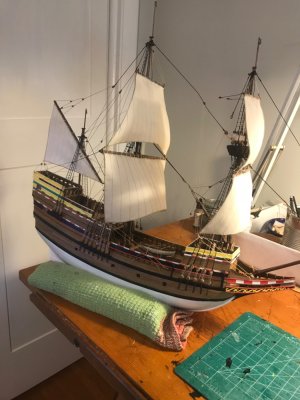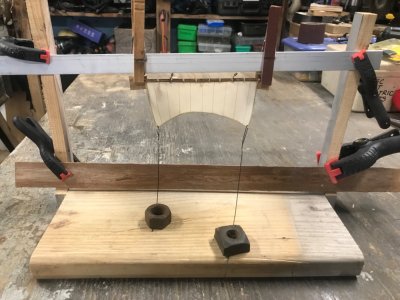-

Win a Free Custom Engraved Brass Coin!!!
As a way to introduce our brass coins to the community, we will raffle off a free coin during the month of August. Follow link ABOVE for instructions for entering.
You are using an out of date browser. It may not display this or other websites correctly.
You should upgrade or use an alternative browser.
You should upgrade or use an alternative browser.
Sails varied in shape, but generally, they were straight along the bottom edge or foot of the sail. Larger main sails sometimes had the foot angle downward near the corners (clews). Most of the curvature you see in a sail is caused by the stretching of the sail wind. Pick up a copy of Historic Ship Models by Wolfram zu Mondfeld. It has lots of pictures and information about ship fittings, hull fittings, and sails covering all time periods and nationalities. It’s a great book for beginners, because it shows you all the basic parts of a sailing ship. It’s also great for learning marine terminology. This book is a favorite of mine. Get it used to save money because it’s only going to get more stained and wrinkled (loved) on you modeling workbench. 
How are you making your sails? You may find the $5 booklet by David Antscherl on making sails from Seawatch Books helpful as well as the video by Tom LauriaI'm adding sails to my Model Shipways Mayflower.
-https://www.youtube.com/watch?v=g_m_VWzk4w8- I wound up using information from both and came up with something in between so know that with this information you can experiment if you wish. They are far superior in appearance to sewn sails at scales of 1:48 and smaller.
Allan
How are you making your sails? You may find the $5 booklet by David Antscherl on making sails from Seawatch Books helpful as well as the video by Tom Lauria
-https://www.youtube.com/watch?v=g_m_VWzk4w8- I wound up using information from both and came up with something in between so know that with this information you can experiment if you wish. They are far superior in appearance to sewn sails at scales of 1:48 and smaller.
Allan
I bought fine, all-cotton muslin cloth from a fabric store and dyed it with tea. for dimensions, I could use the spar lengths for widths and eye ball for heights. I scribed the out lines by pencil and lightly penciled in the seam lines. Then with wood glue, I glued a tan cord ( bolt rope), about .021" around the perimeter on one side. The wood glue disappears when dry. I cut the sail out keeping as close to the bolt rope as I could. Then I glued another bolt rope on the other side of the sail as close to the edge as I could, finishing off the edges. I built a little jig ( pictured ) that clamped to the spar an hooked up temporary sheets to the sail. I used a fan to shape the sail so it looked as if it was catching the wind. Then I sprayed matte varnish about 4 times to keep that shape. The spray brought out little "nubbins" from the cloth itself so it has a rough texture but is not really noticeable. The first picture is of the Mayflower without the sprit sail which was shown in the jig. I like the looks. I tried a flat foot but I prefer the billowing look of a curved foot.How are you making your sails? You may find the $5 booklet by David Antscherl on making sails from Seawatch Books helpful as well as the video by Tom Lauria
-https://www.youtube.com/watch?v=g_m_VWzk4w8- I wound up using information from both and came up with something in between so know that with this information you can experiment if you wish. They are far superior in appearance to sewn sails at scales of 1:48 and smaller.
Allan


How I made sails: Sails for La Couronne
The explanation goes on for several pages...
I used Ohla Batchvarov's method:
Technology for making sails for my models
The explanation goes on for several pages...
I used Ohla Batchvarov's method:
Technology for making sails for my models
- Joined
- Feb 15, 2019
- Messages
- 358
- Points
- 168

Hi Buddy,Sails varied in shape, but generally, they were straight along the bottom edge or foot of the sail. Larger main sails sometimes had the foot angle downward near the corners (clews). Most of the curvature you see in a sail is caused by the stretching of the sail wind. Pick up a copy of Historic Ship Models by Wolfram zu Mondfeld. It has lots of pictures and information about ship fittings, hull fittings, and sails covering all time periods and nationalities. It’s a great book for beginners, because it shows you all the basic parts of a sailing ship. It’s also great for learning marine terminology. This book is a favorite of mine. Get it used to save money because it’s only going to get more stained and wrinkled (loved) on you modeling workbench.
Also George Bandurek's book 'Super detailing the cutter Sherborne'. An outline of the book and sailmaking technique can also be found in an MSW post (the book is probably very hard to lay your hands on, he only had a few left when I got my copy directly from him, a shame, there's a lot of good tips and techniques). I use this method with added refinements such as panels on sails. In future I'll also stitch on the bolt ropes as Olha does rather that rely on glue and it's probable degradation.




